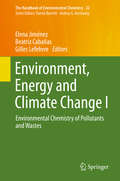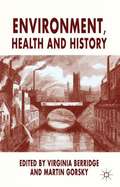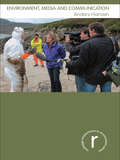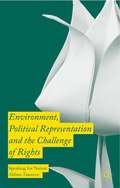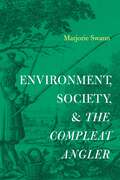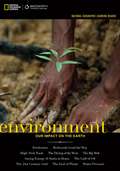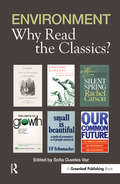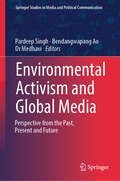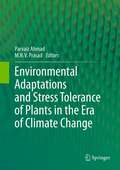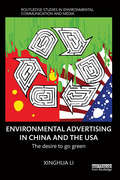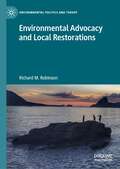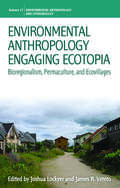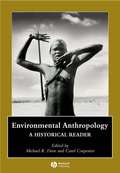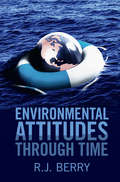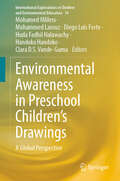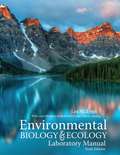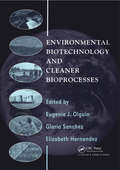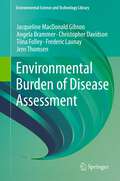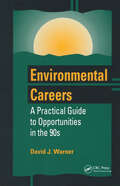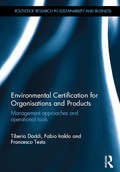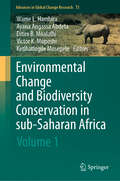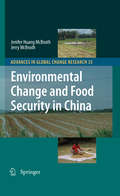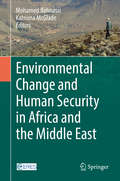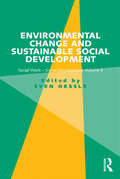- Table View
- List View
Environment, Energy and Climate Change II
by Gilles Lefebvre Elena Jiménez Beatriz CabañasThis volume provides a comprehensive overview of advanced research in the field of efficient, clean and renewable energy production, conversion and storage. The ten chapters, written by internationally respected experts, address the following topics: (1) solar and wind energy; (2) energy storage in batteries; (3) biomass; and (4) socio-economic aspects of energy. Given its multidisciplinary approach, which combines environmental analysis and an engineering perspective, the book offers a valuable resource for all researchers and students interested in environmentally sustainable energy production, conversion, storage and its engineering.
Environment, Health and History
by Virginia Berridge Martin GorskyThe environment is currently a matter of international public and academic concern, but is often considered separately from health issues. This book brings together work from environmental and health historians to conceptualise the connection between environment and health at different times and in different geographical locations.
Environment, Media and Communication
by Anders HansenCommunication about ‘the environment’ in and through a broad array of news, advertising, art and entertainment media is one of the major sources of public and political understanding of definitions, issues and problems associated with the environment. Environment, Media and Communication examines the social, cultural and political roles of the media as a public arena for images, representations, definitions and controversy regarding the environment. The book starts by discussing and outlining a framework for analyzing media and communication roles in the emergence of the environment and environmental problems as issues for public and political concern. It proceeds to examine who and what drives the public agenda on environmental issues, addressing questions about how governments, scientists, experts, pressure groups and other stakeholders have sought to use traditional as well as newer media for promoting their definitions of the key issues. The media are not merely an open public arena or stage, but rather themselves a key gate-keeper and influence in the process of communicating about the environment: the role of news values, organizational arrangements and professional practices, are thus examined next. Recognizing the importance of wider popular culture narratives to public understanding and communication about the environment and nature, the book proceeds with a discussion of the messages and moral tales communicated about the environment, science and nature in a range of media, including film and advertising media. It shows how this wider context provides important clues to understanding the successes and failures of selected environmental issues or campaigns. The book finishes with an examination of the key approaches and models used for understanding how the media influence and interact with public opinion and political decision-making on environmental issues. Offering a comprehensive introduction to theoretical approaches and models for the study of media and communication roles regarding the environment, and drawing on empirical research evidence and examples from Europe, America, Australia and Asia, the book will be of interest to students in media/communication studies, geography, environmental studies, political science and sociology as wll as to environmental professionals and activists.
Environment, Political Representation and the Challenge of Rights: Speaking For Nature
by Mihnea TanasescuTanasescu examines the rights of nature in terms of its constituent parts. Besides offering a thorough theoretical grounding, the book gives a first detailed overview of the actual cases of rights for nature so far. This is the first comprehensive treatment of the rights of nature to date, both analytically and in terms of actual cases.
Environment, Society, and The Compleat Angler (Cultural Inquiries in English Literature, 1400–1700)
by Marjorie SwannFirst published in 1653, The Compleat Angler is one of the most influential environmental texts ever written. Addressing a politically and religiously polarized nation devastated by warfare, disease, ecological degradation, and climate change, Izaak Walton’s famous fishing treatise stages a radical thought experiment: how might humanity’s enhanced relationship with the natural world generate a new kind of sustaining—and sustainable—social order beyond the traditional boundaries of the church, the state, and the biological family?Challenging the current scholarly consensus that reads Walton’s how-to manual as a conservative polemic camouflaged by fishlore, Marjorie Swann examines this richly complicated portrayal of the natural world through an ecocritical lens and explores other neglected aspects of Walton’s writings, including his depictions of social hierarchy, gender, and sexuality. In the process, Swann analyzes a host of noncanonical environmental texts and provides a groundbreaking reappraisal of Charles Cotton’s “Part II” of The Compleat Angler. This study extends the hydrological turn in early modern ecocriticism and demonstrates how, as a genre, angling manuals provide new insights into the environmental, cultural, social, and literary history of early modern England.Taking its place alongside landmark works of ecocriticism such as Green Shakespeare and Milton and Ecology, this fresh and timely reassessment of The Compleat Angler rightly ranks Izaak Walton among the most important environmental writers of the early modern era.
Environment: Our Impact on the Earth
by National Geographic LearningThis book covers many issues regarding the planet and humans' contributions to its environmental issues and discusses ways that humans are trying to preserve the planets resources and species, find new ways to recycle those resources, and help each other. .
Environment: The Science Behind the Stories (Second Edition)
by Scott Brennan Jay Withgott"Environment: The Science Behind the Stories" is an introductory textbook that uses case studies and real data to demonstrate the role of science in identifying and solving pressing environmental problems. The book integrates case studies into the body of the text to provide a contextual framework for the science readers are learning. With only 22 chapters, this book avoids the encyclopedic approach of other textbooks on the market. A panoramic view of environmental science and issues, including the important policy, economic, and ethical issues behind the scientific ones. For college instructors, students, and anyone interested in environmental science and issues.
Environment: Why Read The Classics?
by Sofia Guedes VazEnvironment: Why Read the Classics? presents six important essays by some of the world's leading environmental thinkers on six of the most emblematic books ever written on the environment. The books – Walden; A Sand County Almanac; Small is Beautiful; Silent Spring; The Limits to Growth; and Our Common Future – taken together have been hugely important in the development of global environmental awareness, activism and policy. The essayists – Viriato Soromenho-Marques, J. Baird Callicott, José Lima Santos, Tim O'Riordan, Satish Kumar and Marina Silva – invite readers to reflect on these ground-breaking works and examine their historical importance, as well as what they should mean to us today and what relevance they will have to future generations. More than just books about the environment, these are also philosophical treatises, in that they increase our understanding of the natural world and of ourselves, calling us "to weigh and consider", as Bacon put it. In particular, they make us reflect on the need to constantly redefine the purposes of progress, the economy and society. How we relate to nature is a crucial aspect in the plans we make as a species, and as individuals; and every one of these books inspires a more respectful relationship, both with nature and humanity, and consequently with ourselves. The six essays in this book are the result of a series of conferences organised in Lisbon by the Calouste Gulbenkian Foundation with the support of the American Embassy in Portugal. Its *raison d'être* was to revisit the ideas that have shaped the environmental movement, seeking inspiration to deal with what looks like a very challenging future. The significance of such timeless concepts is now more apparent than ever; and these evergreen books are full of ideas that retain their spark even in our difficult times. This is what makes them classics. Environment: Why Read the Classics? is a provocative book and will be essential reading for all those concerned about the state of the world.
Environmental Activism and Global Media: Perspective from the Past, Present and Future (Springer Studies in Media and Political Communication)
by Pardeep Singh Bendangwapang Ao Dr MedhaviThis scholarly work discusses the historical, contemporary, and prospective dimensions of environmental activism and its intersection with global media. It provides a comprehensive view of the pivotal role played by the media in shaping awareness concerning environmental challenges and catalyzing actions to address them. Drawing upon the insights of an interdisciplinary cohort of scholars, the book systematically examines the diverse aspects of the nexus between media and environmental activism. Chapter contributions establish the foundational framework for comprehending how media as a whole lend support to activism; delineate the historical trajectory of environmental activism; the construction of narratives within the political, economic, and social domains of society; scrutinize the function of mass media within the context of globalization, digitization, and social media; and elucidate how governance structures influence the environmental activism process. By introducing readers to the basic narrative in environmental activism, globalization, and media, this book will be an important source of information for researchers, academicians and students engaged in various interdisciplinary studies linked to media, environment and activism.
Environmental Adaptations and Stress Tolerance of Plants in the Era of Climate Change
by Parvaiz Ahmad M.N.V. PrasadClimate change is a complex phenomenon with a wide range of impacts on the environment. Biotic and abiotic stress are a result of climate change. Abiotic stress is caused by primary and secondary stresses which are an impediment to plant productivity. Prolonged exposure to these stresses results in altered metabolism and damage to biomolecules. Plants evolve defense mechanisms to withstand these stresses, e.g. synthesis of osmolytes, osmoprotectants, and antioxidants. Stress responsive genes and gene products including expressed proteins are implicated in conferring tolerance to the plant. This volume will provide the reader with a wide spectrum of information, including vital references. It also provides information as to how phytoconstituents, hormones and plant associated microbes help the plants to tolerate the stress. This volume also highlights the use of plant resources for ameliorating soil contaminants such as heavy metals. Dr. Parvaiz is Assistant professor in Botany at A.S. College, Srinagar, Jammu and Kashmir, India. He has completed his post-graduation in Botany in 2000 from Jamia Hamdard New Delhi India. After his Ph.D from the Indian Institute of Technology (IIT) Delhi, India in 2007 he joined the International Centre for Genetic Engineering and Biotechnology, New Delhi. He has published more than 20 research papers in peer reviewed journals and 4 book chapters. He has also edited a volume which is in press with Studium Press Pvt. India Ltd., New Delhi, India. Dr. Parvaiz is actively engaged in studying the molecular and physio-biochemical responses of different plants (mulberry, pea, Indian mustard) under environmental stress. Prof. M.N.V. Prasad is a Professor in the Department of Plant Sciences at the University of Hyderabad, India. He received B.Sc. (1973) and M.Sc. (1975) degrees from Andhra University, India, and the Ph.D. degree (1979) in botany from the University of Lucknow, India. Prasad had published 216 articles in peer reviewed journals and 82 book chapters and conference proceedings in the broad area of environmental botany and heavy metal stress in plants. He is the author, co-author, editor, or co-editor for eight books. He is the recipient of Pitamber Pant national Environment Fellowship of 2007 awarded by the Ministry of Environment and Forests, Government of India.
Environmental Advertising in China and the USA: The desire to go green (Routledge Studies in Environmental Communication and Media)
by Xinghua LiSince the late 1980s, green consumerism has been hailed in the West as an efficient solution to environmental problems. However, Chinese consumers have been slow to warm up to eco-friendly products. Consumers prefer SUVs to hybrid cars, health supplements and snake oil medicines to organic foods and eco-fashion is still secluded in high-end designer studios. These choices contradict the findings of many sustainable lifestyle surveys that claim to register a rising desire for green products among the Chinese. This book examines the psycho-cultural differences that disrupt the translation of "eco-friendly" appeals to China by analyzing environmental advertising. It explores the different notions of "green", the structures of desire that underlies the advertisements, and how they are shaped by ideological, cultural, and historical differences. Rather than arguing the superiority of the American or Chinese version of green consumerism, the book interrogates the role of advertising in the global spread of Western ideologies and explores the possibilities for consumers to resist transnational corporate hegemony in the green movement. This book fills an important gap in the critical scholarship on green marketing and should be of interest to students and scholars of environment studies, green advertising and marketing, environmental communication and media studies, China studies and environmental sociology, ethics and cultural studies.
Environmental Advocacy and Local Restorations (Environmental Politics and Theory)
by Richard M. RobinsonThis book explores the leadership of state and federal environmental agencies and local environmental groups in restoring the degraded rivers that flow into North America’s Great Lakes and other sites in the northeastern industrial corridor of the US. Robinson examines twenty of the forty-eight sites included in the Areas of Concern Program of the Great Lakes Water Quality Agreement between Canada and the US. These twenty include heavily urbanized locales such as those along the River Rouge and Detroit River, but also more pristine locales such as the St. Louis River that flows through Duluth. Additionally, Robinson examines challenging river restorations within the northeastern industrial corridor which are led by effective local environmental advocacy organizations: the Penobscot Nation of Indigenous People, the Mystic River Watershed Association, and the Housatonic River Valley Association. All of these river restorations are led and managed by the environmental experts of (i) state and federal agencies, (ii) academia, and (iii) environmental NGOs. Local restorations of industrially degraded water bodies now compose a significant segment of the environmental movement and, ultimately, Robinson demonstrates that local environmental advocacy organizations can help marshal state and local funding for those efforts.
Environmental Anthropology Engaging Ecotopia
by Joshua Lockyer James R. VetetoIn order to move global society towards a sustainable "ecotopia," solutions must be engaged in specific places and communities, and the authors here argue for re-orienting environmental anthropology from a problem-oriented towards a solutions-focused endeavor. Using case studies from around the world, the contributors-scholar-activists and activist-practitioners- examine the interrelationships between three prominent environmental social movements: bioregionalism, a worldview and political ecology that grounds environmental action and experience; permaculture, a design science for putting the bioregional vision into action; and ecovillages, the ever-dynamic settings for creating sustainable local cultures.
Environmental Anthropology: A Historical Reader
by Michael R. Dove Carol CarpenterEnvironmental Anthropology: A Reader is a collection of historically significant readings, dating from early in the twentieth century up to the present, on the cross-cultural study of relations between people and their environment. Provides the historical perspective that is typically missing from recent work in environmental anthropology Includes an extensive intellectual history and commentary by the volume's editors Offers a unique perspective on current interest in cross-cultural environmental relations Divided into five thematic sections: (1) the nature/culture divide; (2) relationship between environment and social organization; (3) methodological debates and innovations; (4) politics and practice; and (5) epistemological issues of environmental anthropology Organized into a series of paired papers, which 'speak' to each other, designed to encourage readers to make connections that they might not customarily make
Environmental Attitudes Through Time
by R. J. BerryOur attitudes to our environment are widely and often acrimoniously discussed, commonly misunderstood, and will shape our future. We cannot assume that we behave as newly minted beings in a pristine garden nor as pre-programmed automata incapable of rational responsibility. <P><P>Professor Berry has studied nature-nurture interactions for many years, and also been involved with many national and international decision making bodies which have influenced our environmental attitudes. He is therefore well-placed to describe what has moulded our present attitudes towards the environment. <P>This book presents data and concepts from a range of disciplines - genetic, anthropological, social, historical and theological - to help us understand how we have responded in the past and how this influences our future. Beginning with a historical review and moving forwards to current conditions, readers will reach the end of this volume more capable and better prepared to make decisions which affect our communities and posterity.<P> Accessibly written, requiring no specific background knowledge of the reader.<P> Suggests actions the reader can take at both an individual and societal level.<P> Provides the historical context necessary to rise above the propaganda and vested interests which dominate current environmental debate.
Environmental Awareness in Preschool Children’s Drawings: A Global Perspective (International Explorations in Outdoor and Environmental Education #14)
by Mohamed Mliless Mohammed Larouz Diego Luis Forte Huda Fadhil Halawachy Handoko Handoko Clara D. S. Vande-GumaThis edited volume investigates multiple perspectives of environmental meaning-making among children by evaluating preschool children’s drawings on the environment. It critically traces the formation of early attitudes towards the environment before children’s exposure to formal environmental education. Similarities and differences are explored among preschool children's drawings across diverse cultural and geographic backgrounds. Over five sections covering Morocco, Indonesia, Nigeria, Iraq, and Argentina, each one examines the factors affecting children's environmental drawings, such as age, gender, and geography. Using different theoretical frameworks, the chapters are written by researchers of environmental discourse and ecolinguistics with a background knowledge in environmental studies from a social science perspective. This book is of interest to researchers interested in ecolinguistics and socio-semiotics fields of study. This seminal book also paves the way for further research on preschool environmental education.
Environmental Biology and Ecology Laboratory Manual
by Les M LynnIn a society concerned with climate change, overpopulation, and extinction, ecology provides a scientific link to the living world. At the individual level, ecology investigates the impact of environmental factors on organisms through their physiology and behaviour. This Sixth Edition of Environmental Biology & Ecology Laboratory Manual by Les M. Lynn contains fifteen exercises which includes Use of the Microscope and also Environmental Inventory. This will be a very useful manual and research guide for students of Environmental Biology and Ecology.
Environmental Biotechnology and Cleaner Bioprocesses
by Eugenia J. Olguín, Gloria Sánchez, Elizabeth HernándezAs we enter a new millennium, the environmental issues faced by both developing and industrialised nations are as pressing as ever. Environmental biotechnologies are increasingly being viewed as a major weapon against environmental damage. Cleaner production is part of this strategy and yet there is still widespread ignorance about this emerging technology. Environmental Biotechnology and Cleaner Bioprocesses provides this information at various levels, from introductory to advanced. The first section covers the development of cleaner bioprocesses within the framework of sustainable development. Aspects of environmental policy for small and medium businesses are then discussed using case studies to illustrate principles. The second section covers the recycling and treatment of organic waste, including the use of aquatic plants and microalgae for wastewater treatment and recovery of nutrients. Section three covers bioremediation technologies and finally, section four is dedicated to emerging cleaner bioprocesses and environmentally sound products. All chapters have been written and edited by leading authorities in the field. Students and professionals interested in environmental biotechnology and cleaner production will find the background information and detail they require in this one convenient source.
Environmental Burden of Disease Assessment
by Christopher Davidson Angela Brammer Jens Thomsen Frederic Launay Tiina Folley Jacqueline Macdonald GibsonThis publication characterizes the environmental burden of disease in the United Arab Emirates (UAE), measured by the excess number of deaths and illnesses in the population due to exposure to environmental hazards. The robust methods used in this risk analysis can be applied to any country or region. This publication documents the systematic, multi-step process used to identify environmental priorities and the detailed methods used to quantify the disease burden attributable to each risk. Based on the results of the burden of disease assessment, the publication summarizes the subsequent steps that are recommended to further reduce the burden of disease resulting from various environmental risk factors. Authors and Contributors This book represents the synthesis of research carried out by a large, interdisciplinary team from several institutions and multiple nations between June 2008 and June 2011.The lead authors are responsible for weaving together the pieces prepared by the team.Nonetheless, this book would not have been possible without major contributions from each team member.The list below shows contributors to each chapter.Following this list are biographies of all of the authors and contributors. Lead Authors Jacqueline MacDonald Gibson, Frederic J. P. Launay, Jens T. W. Thomsen, Angela Brammer, Christopher Davidson Additional Contributors (by Chapter) Chapter 2: Prioritizing Environmental Risks to Health Henry H. Willis, Aimee Curtright, Gary Cecchine, Zeinab S. Farah,Sandra A. Geschwind, Jianhui Hu, Ying Li, Melinda Moore, Sarah Olmstead, Hanine Salem, Regina A. Shih, J. Jason West Chapter 3: Assessing the Environmental Burden of Disease:Method Overview Tiina Folley, Elizabeth S. Harder, Mejs Hasan Chapter 4: Burden of Disease from Outdoor Air Pollution Ying Li, Gavino Puggioni, Prahlad Jat, Mejs Hasan, Marc Serre, Kenneth G. Sexton, J. Jason West, Saravanan Arunachalam, Uma Shankar, William Vizuete, Mohammed Zuber Farooqui Chapter 5: Burden of Disease from Indoor Air Pollution Chris B. Trent Chapter 6: Burden of Disease from Occupational Exposures Tiina Folley, Leena A. Nylander-French Chapter 7: Burden of Disease from Climate Change Richard N. L. Andrews, Leslie Chinery, Elizabeth S. Harder, J. Jason West Chapter 8: Burden of Disease from Drinking Water Contamination Gregory W. Characklis, Joseph N. LoBuglio Chapter 9: Burden of Disease from Coastal Water Pollution Gregory W. Characklis, Leigh-Anne H. Krometis, Joseph N. LoBuglio Chapter 10: Burden of Disease from Soil and Groundwater Contamination Chidsanuphong Chart-asa, Stephanie Soucheray-Grell Chapter 11: Burden of Disease from Produce and Seafood Contamination Leigh-Anne H. Krometis, Leslie Chinery
Environmental Careers: A Practical Guide to Opportunities in the 90s
by David J. WarnerEnvironmental Careers presents a broad-based, yet concise survey of employment opportunities in the environmental field. The book stresses the need for students to develop a strong technical background in the sciences to be effective in understanding and solving complex environmental problems. It also emphasizes the importance of developing relevant work experience through internships or volunteer work to help find entry-level employment in the environmental field. Environmental Careers includes opportunities in natural resources management, environmental protection, environmental health and safety, environmental education, allied environmental careers, and non-degree technical careers. Important issues for students, guidance counselors, and mid-career changers, such as salaries, characteristics of employers, and the latest trends in demands for environmental professionals, are addressed. The book also presents the 10 best career prospects for the 1990s and offers guidance on developing and implementing a personal action plan for pursuing an environmental career.
Environmental Certification for Organisations and Products: Management approaches and operational tools (Routledge Research in Sustainability and Business)
by Francesco Testa Tiberio Daddi Fabio IraldoEnvironmental certification is an effective tool for managing the environmental impact of companies, leveraging their competitive capabilities and ensuring their compliance with environmental principles. A growing number of countries across the world are adopting this practice and the growth of new environmental standards – with different scopes, aims and roles – calls for a clear and updated systematization of the issue. This book provides a comprehensive, up-to-date overview of the different environmental certification tools. As well as examining practical methods of implementing the standards for each type of certification, the book discusses their added value from a corporate management perspective. In identifying the most important requirements and standards for the issuing of environmental certification of both products and processes, the book demonstrates how companies can use operational methods to develop an environmental management system or a product certification in practice. Balancing a complete theoretical presentation of the issue with an operational perspective, the book supports the adoption and implementation of environmental certification tools. It will be a valuable resource for professionals as well as students and scholars of environmental management, sustainable business and corporate social responsibility.
Environmental Change and Biodiversity Conservation in sub-Saharan Africa: Volume 1 (Advances in Global Change Research #75)
by Wame L. Hambira Ayana Angassa Abdeta Ditiro B. Moalafhi Victor K. Muposhi Ketlhatlogile MosepeleThis volume set provides critical strategies for sustainable environmental management and biodiversity conservation in sub-Saharan Africa. They address key conservation issues in the region such as habitat loss, fragmentation, rangeland degradation, and human-wildlife conflicts. Innovative approaches in ecological modelling, climate change adaptation, and circular water systems, enhancing conservation efforts and ensuring resilience in the face of environmental changes are further examined. A comprehensive analysis of fisheries management and sustainable practices underscores their role in conserving aquatic biodiversity. Despite challenges like agricultural expansion and water scarcity, the focus on regenerative agriculture and food production systems seeks to mitigate impacts on rangelands and forests, thus supporting biodiversity conservation. Emphasizing the integration of traditional knowledge with contemporary conservation science, these volumes highlight the need for holistic, adaptive strategies and robust governance frameworks to address the complexities of biodiversity loss and environmental change. The collection is an essential resource for policymakers, researchers, and conservation practitioners dedicated to fostering sustainable livelihoods and conserving the unique ecosystems of sub-Saharan Africa. Volume 1 covers the themes of biodiversity conservation in the Anthropocene and sustainable rangeland and forest management. It provides an understanding of the dual impacts of human activities on biodiversity and underscores the necessity of sustainable forest management to enhance ecosystem services vital for rural livelihoods, economic growth, and ecological health amid environmental and human pressures.
Environmental Change and Food Security in China
by Jenifer Huang Mcbeath Jerry McbeathWith 22 percent of the world's population but only 7 percent of its arable land, China's food situation is a matter of global concern. This volume is the first to introduce comprehensively the threats to China's system of food production, distribution, and consumption. It analyzes broad challenges of population growth, urbanization, and extraordinarily rapid economic development. Then it focuses on degradation of China's land, water and air, water sufficiency, and evidence of climate change effects as they adversely affect the food system. The study investigates plant diseases and pests which take a large toll on agricultural production and also considers alien invasive species. Normal bureaucratic routines of agricultural, land, water, climatological, and environmental agencies are inadequate to counter these challenges, and the regime has launched large projects (e.g., the South-North Water Diversion Project) and conducted national campaigns (e.g., re- and afforestation programs) which are unprecedented in their scope. Also, China has invested more heavily in agricultural biotechnology research than any other developing country. These responses have insured self-sufficiency in food staples to the present. The volume evaluates several future problems and issues in China's approach to food security. Despite attempts to tighten coordination of policy and improve enforcement, as seen in efforts to resolve the tainted products crisis of 2007, the increased autonomy of local governments often frustrates green and clean ambitions of the state. Although the regime has tolerated environmental and other NGOs, allowed the media greater latitude to report bad news, and permitted protests that do not challenge the communist party's authority, still civil society is weak. While economic development has lifted more than 200 million from poverty, rural/urban inequality increases, pushing the poor into China's cities, and access to food remains a problem for many.
Environmental Change and Human Security in Africa and the Middle East
by Mohamed Behnassi Katriona McgladeThis volume brings together insights on the interactions between environmental change and human security in the Middle East and Africa. These regions face particular challenges in relation to environmental degradation, the decline of natural resources and consequent risks to current and future human security. The chapters provide topical analysis from a range of disciplines on the theory, discourse, policy and practice of responding to global environmental change and threats to human security. Case studies from Morocco, Tunisia, Egypt, Turkey, Iraq and Syria provide empirical evidence, with a focus section dedicated to the critical issue of water resources and water security in the region. The contributions demonstrate above all that the risks posed to human security arise through multiple and interconnected processes operating across diverse spatial and temporal scales. The complexity of these processes requires new ways of thinking and intervening. As a contribution, the current volume provides engaging insights from theory and practice for those seeking to address the challenges of environmental change.
Environmental Change and Sustainable Social Development: Social Work-Social Development Volume II
by Sven HessleHow does climate change affect social work and social development? What actions are needed to integrate the three pillars of economic development, environmental development and social protection? With global warming and the increase in natural disasters due to the emission of greenhouse gases, an alternative approach to the natural environment is vital. The main focus of this volume is to emphasize the person-in-environment concept and to find measures for its implementation. For social work the environment has traditionally been viewed as a world of human relationships as opposed to the interaction between man and environment. This informative and incisively written edited collection brings together experts from around the world to analyze the person-in-environment concept and to find measures for its implementation. Through the presentation of theoretical and practical platforms for environmental social work or ’green social work’, we hope to bring about a new paradigmatic shift in our attitude to the concept of person-in- environment.
